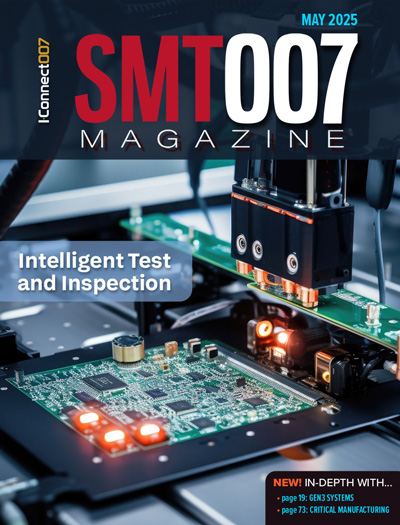-

- News
- Books
Featured Books
- smt007 Magazine
Latest Issues
Current Issue
What's Your Sweet Spot?
Are you in a niche that’s growing or shrinking? Is it time to reassess and refocus? We spotlight companies thriving by redefining or reinforcing their niche. What are their insights?

Moving Forward With Confidence
In this issue, we focus on sales and quoting, workforce training, new IPC leadership in the U.S. and Canada, the effects of tariffs, CFX standards, and much more—all designed to provide perspective as you move through the cloud bank of today's shifting economic market.

Intelligent Test and Inspection
Are you ready to explore the cutting-edge advancements shaping the electronics manufacturing industry? The May 2025 issue of SMT007 Magazine is packed with insights, innovations, and expert perspectives that you won’t want to miss.
- Articles
- Columns
- Links
- Media kit
||| MENU - smt007 Magazine
In-Circuit Pin Testing: An Excellent Potential Source of Value Creation
June 17, 2015 | Mitch Holtzer, AlphaEstimated reading time: 2 minutes
In-circuit pin testing (ICT) is a common method of inspecting electronic assemblies to measure the effectiveness of the assembly process and to predict electrical functionality. Test probes are put in contact with dedicated test points along the surface of an assembly, checking for electrical functions such as resistance, capacitance inductance and signal timing. Some circuit assemblers use functional testing for quality assurance as a substitute for ICT. In this example, the entire assembly either works or it doesn’t.
Unlike printing paste, placing components and reflowing solder, ICT is considered a non-value added process. In fact, ICT increases the cycle time of the assembly process. If the ICT is a fail, but the circuit being tested is actually good (known as a false negative), even more time is wasted trying to determine whether or not a good assembly will function properly.
The two basic types of ICT are commonly referred to as clamshell and flying probe. The clamshell ICT simultaneously tests dozens of points on a single board. One laboratory type of clamshell ICT device uses three types of pins and four different forces. A test vehicle is placed in the clamshell fixture. The clamshell is closed, and electrical resistivity is measured at each of the test pins.
Although clamshell devices are commonly used, they are somewhat impractical for testing solder paste and flux’s ability to be probed. Typically, there can be a 15-minute cycle time per test. Pin residue build up generally occurs after hundreds of tests. Cleaning flux build-up from pins is time-consuming, but necessary to minimize false negative readings.
Clamshell fixtures are quite expensive. A customized fixture must be fabricated for each unique assembly. This cost is only justified for the testing of high-value or high-volume assemblies.
Flying probe testing is also commonly used for lower value or lower volume assemblies. Flying probes test sequences are determined by easily changeable programming inputs. Clamshell fixtures are not required. Therefore, this type of test method is more suited for high mix circuit assembly applications.
In a common laboratory flying probe procedure, one pin type and one force are used, but the test runs for a total of 4,000 strikes. Flux build-up on the pins is an important part of the test. In addition, one common laboratory test vehicle contains four different types of pads. In this example, pad A is a 40 mil (1mm) square pad without vias, pad B is a 40 mil (1mm) square pad with 13 mil (0.33mm) vias, pad C is a 28 mil (0.7mm) round pad without vias, and pad D is a 28 mil (0.77mm) round pad with 13 mil (0.33mm) vias. There are 1,000 opportunities for each pad type.
Read The Full Article Here
Editor's Note: This article originally appeared in the June 2015 issue of SMT Magazine.
Suggested Items
Driving Innovation: Direct Imaging vs. Conventional Exposure
07/01/2025 | Simon Khesin -- Column: Driving InnovationMy first camera used Kodak film. I even experimented with developing photos in the bathroom, though I usually dropped the film off at a Kodak center and received the prints two weeks later, only to discover that some images were out of focus or poorly framed. Today, every smartphone contains a high-quality camera capable of producing stunning images instantly.
Hands-On Demos Now Available for Apollo Seiko’s EF and AF Selective Soldering Lines
06/30/2025 | Apollo SeikoApollo Seiko, a leading innovator in soldering technology, is excited to spotlight its expanded lineup of EF and AF Series Selective Soldering Systems, now available for live demonstrations in its newly dedicated demo room.
Indium Corporation Expert to Present on Automotive and Industrial Solder Bonding Solutions at Global Electronics Association Workshop
06/26/2025 | IndiumIndium Corporation Principal Engineer, Advanced Materials, Andy Mackie, Ph.D., MSc, will deliver a technical presentation on innovative solder bonding solutions for automotive and industrial applications at the Global Electronics A
Fresh PCB Concepts: Assembly Challenges with Micro Components and Standard Solder Mask Practices
06/26/2025 | Team NCAB -- Column: Fresh PCB ConceptsMicro components have redefined what is possible in PCB design. With package sizes like 01005 and 0201 becoming more common in high-density layouts, designers are now expected to pack more performance into smaller spaces than ever before. While these advancements support miniaturization and functionality, they introduce new assembly challenges, particularly with traditional solder mask and legend application processes.
Knocking Down the Bone Pile: Tin Whisker Mitigation in Aerospace Applications, Part 3
06/25/2025 | Nash Bell -- Column: Knocking Down the Bone PileTin whiskers are slender, hair-like metallic growths that can develop on the surface of tin-plated electronic components. Typically measuring a few micrometers in diameter and growing several millimeters in length, they form through an electrochemical process influenced by environmental factors such as temperature variations, mechanical or compressive stress, and the aging of solder alloys.


